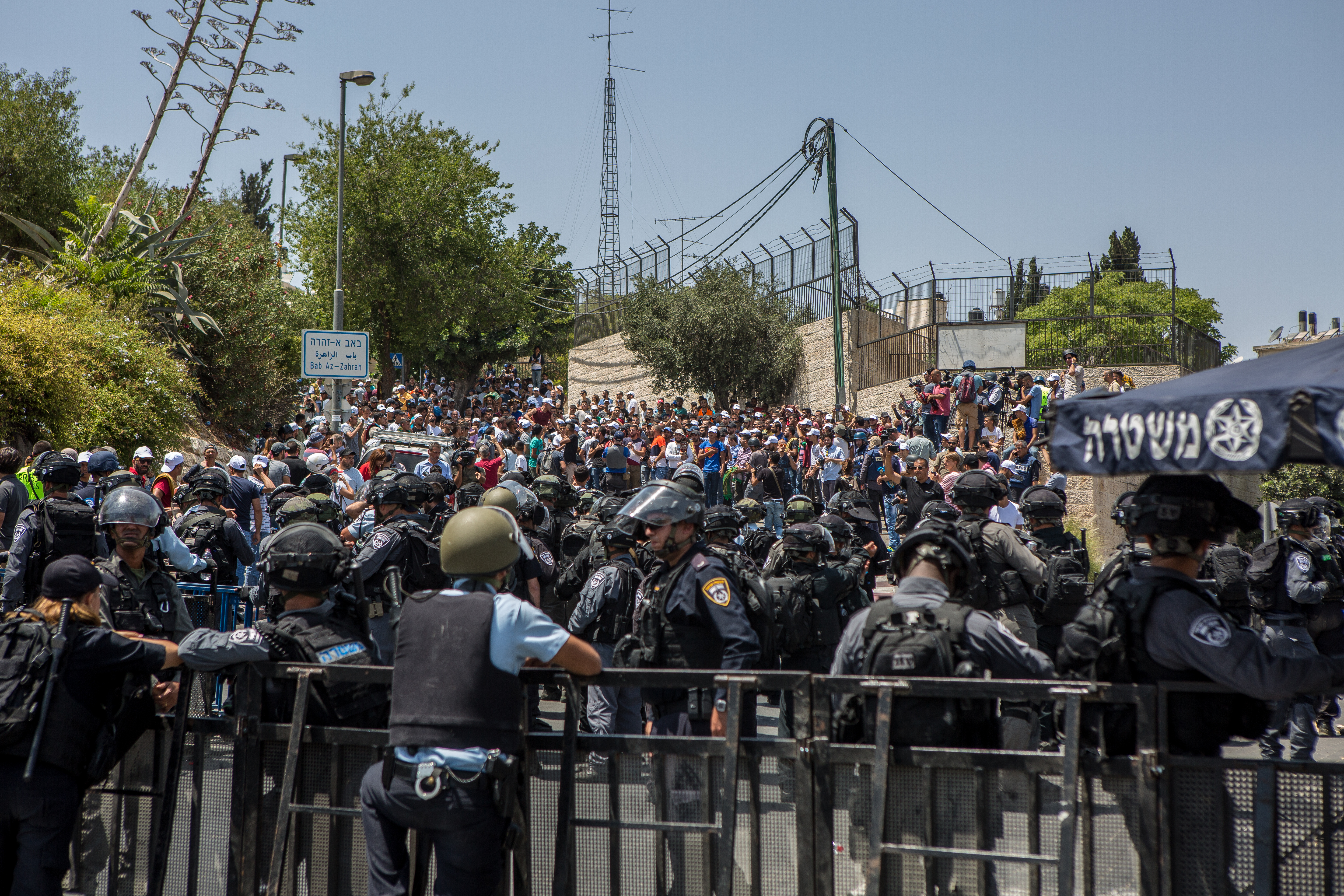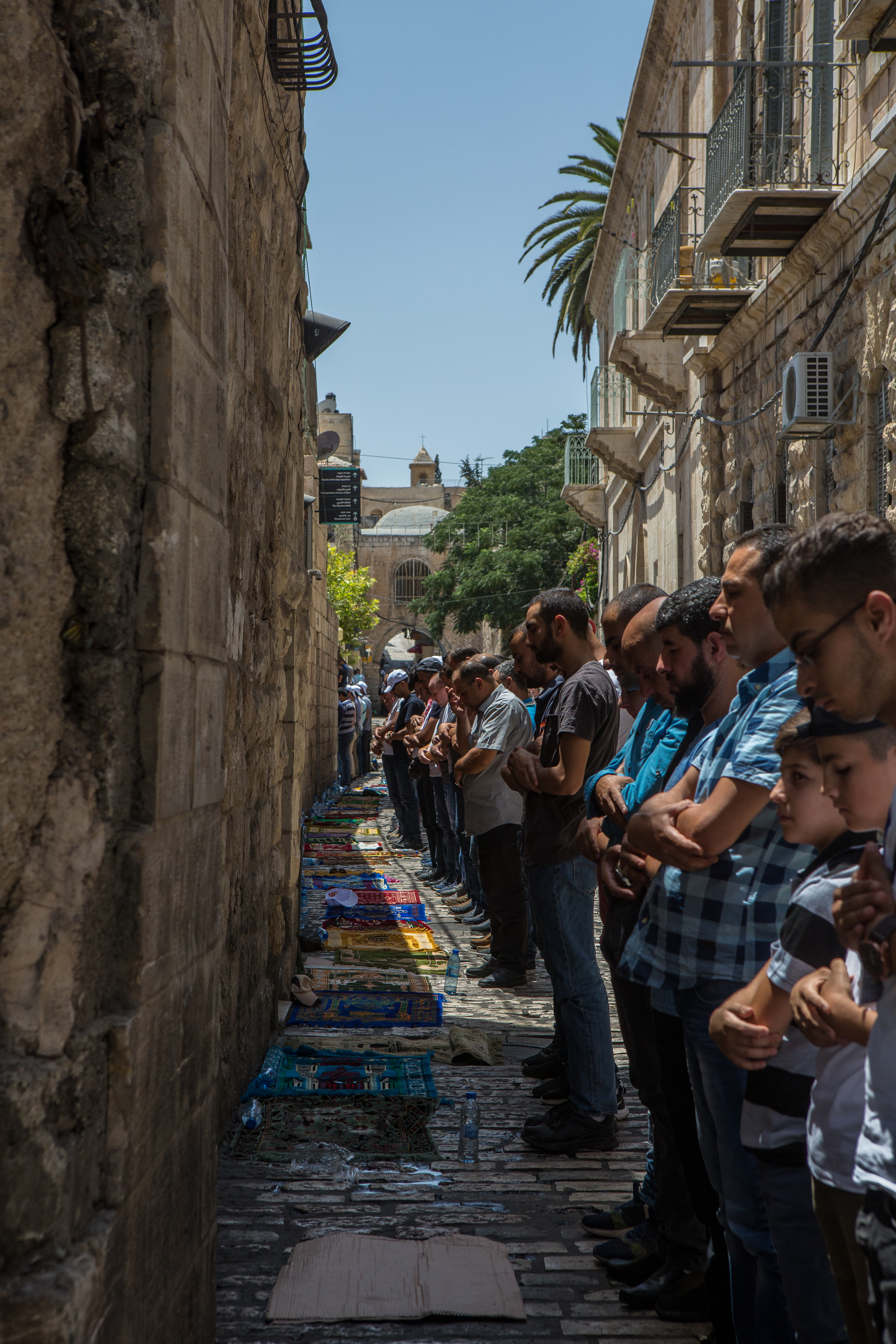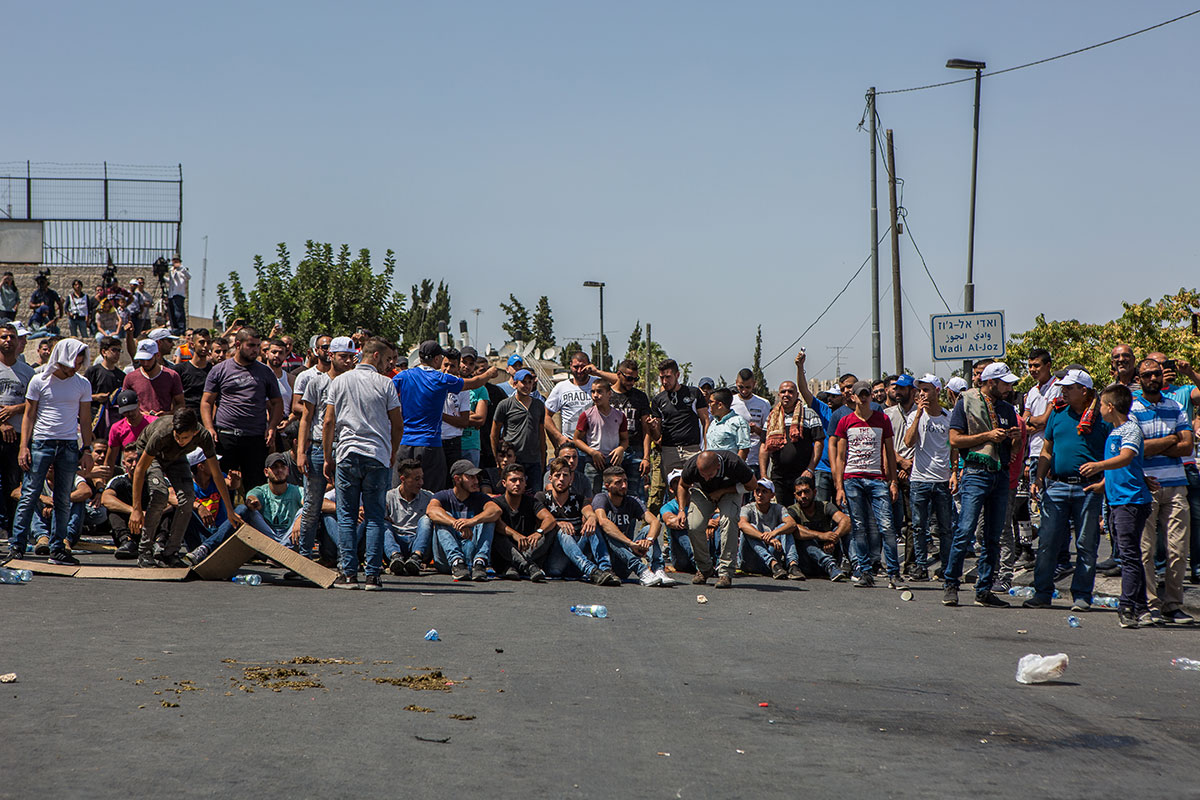The promenade leading from Mount Scopus to the Mount of Olives along the promontory overlooking Jerusalem is our daily solace. The panoramic vista abounds with religious symbolism. In this image, sacrosanct to every Palestinian, the houses pile high, one on top of the other behind the great wall that surrounds the city. From this perspective Jerusalem emerges as a still life; a stone sculpture of domes of various shapes and volumes on top of squares punctuated by minarets, belfries, crosses, and crescents. The golden Dome of the Rock dominates the picture. To its left, the lead dome of Al-Aqsa Mosque hides behind cypress trees. In the upper left stands the solemn rotunda that marks the Church of the Holy Sepulcher.
Summer or winter, wrapped in mist, camouflaged in clouds, in daylight or at night, the shimmering golden Dome of the Rock exerts a reassuring presence. Before one leaves on a trip and first thing upon returning home, the cursory ride through Mount Scopus is a must. Nothing is finer than waking up early in the morning and rushing to witness the first sunlight or enjoying a late-afternoon ride to catch the sunset over our beloved city. The colors, hues, and values change with the change of season, from the beautiful pink of the warm autumnal days to the lead grey that filters through the raindrops on the windshield of the car. Mornings and evenings, at all hours, the sight of the Dome of the Rock gives us our raison d’être, a positive reaffirmation that legitimizes against all odds our survival in Jerusalem. We are comforted by its sight; it validates our sense of identity and reconfirms our bonds to the city. With the Dome of the Rock within sight, we live in a state of grace, a moment of bliss – were it not tainted by the fear of the imminent loss of Al-Aqsa. The threat that Al-Aqsa is in danger is a nightmare that haunts us.

The politicizing of the sacred space undermines its sanctity. The slogan “Al-Aqsa Is in Danger” dates back to Al-Hajj Ameen al-Husseini, following the destructive earthquake of 1927. It was coined to rally the Muslim world to the rescue of Palestine and to alert them to the grievous situation of Mandate Palestine.
The catchphrase, which continues to be used by the Awqaf (Muslim endowment) and Palestinian politicians, maintains the state of alarm and stirs up anxiety and fear that the Israelis will break the established status quo and take over Al-Aqsa. The instrumentalization of the Noble Sanctuary by both Israelis and Palestinians for political ends touches on issues of sovereignty, religious freedom, military occupation, the forcible annexation of Jerusalem to Israel, the demolition of homes, and Palestinian nationalism. By the same token, members of the Israeli right wing, through their various statements and forced attempts under Israeli police protection to undo the status quo, undermine the Jordanian sovereignty over the compound, and hold Jewish prayers within it are political ploys that desecrate the holiness of the mosque.
For two weeks last July, Jerusalem stood still. The Israeli authorities shut the gates that lead to the esplanade of The Noble Sanctuary (Al-Haram al-Sharif). While Palestinians were barred entry to the mosque, Israelis rummaged through every nook and cranny of the entire area. The closing of Al-Aqsa Esplanade, something that rarely happens, meant that the Friday noon prayers, which typically draw tens of thousands of Muslims from Greater Jerusalem and the West Bank to the compound, were cancelled. In an open act of nonviolent civil disobedience, Jerusalemites performed the Friday prayers in the streets north of the walls of the Old City instead.

The pathos of the moment was captured in a plethora of pictures deployed in social media and various press releases. As the Israeli army forbade anyone under the age of 50 from accessing the areas inside the walls of the Old City, the multitudes took to prayers in the streets north of Herod’s and Damascus gates. Salah al-Din Street, Al-Rashid, and Nablus Road thronged with rows of men and women of all ages. The spectacle was awesome: a testimony to Christian-Muslim solidarity as Christians bearing the symbol of the cross stood next to their Muslim brothers and prayed.
As the closure was prolonged, the conspicuous silence of the Muslim world, with the exception of Turkey, was ominous. Forbidden access to the Noble Sanctuary, Jerusalemites felt de-centered, uneasy, and restive. Everyone milled around the exterior of Al-Aqsa, unhinged as though thrown out of paradise. Funerals could no longer take place in Al-Aqsa. None of the five daily prayers could be held. Even the gentle, spiritually restorative walk within the sacred grounds of the holiest place in Islam had become a thing of the past. Heavy, silent days passed, filled with prayers and implorations to God, waiting for a miracle.
Since the Holy Rock الصخرة المشرفة)), enshrined under the golden Dome of the Rock, has witnessed the rupture of the sacred in Islam, the Noble Sanctuary has an exalted position in Muslim theology. In both Mecca and Medina, Allah merely dispatched Gabriel to relay messages to the Prophet. Only in Jerusalem, during the Night of Al-Isra’ wal-Mi’raj (the Night Journey) did God connect with the Prophet directly, whence Prophet Muhammad was in the divine presence فكان قاب قوسين او ادنى)). Henceforth, the Holy Rock and the city, which were both blessed that night, gave Jerusalem a distinguished status as the Home of the Blessed (Rock) – in contradistinction to Mecca, symbol of the Abrahamic tradition, and Medina, where the Prophet, considered very human and a messenger of Allah, is buried.
The closure of the Noble Sanctuary is insidious and symptomatic of the general crisis in Sunni Islam under Saudi Arabian hegemony. In Saudi Arabia, Wahhabi Sunni Islam is in open conflict with Iran and Shi’ism. As the Saudi administration over the holy sites in Al-Hejaz includes economic and political monopoly of religious tourism, and as it exercises strict control of Islamic practices, to the degree of imposing its own strictures in religious rites of pilgrimage and prayers on all Muslim sects and ethnicities according to the precepts of Wahhabi Islam and to the exclusion of others, Iran has declared Karbala as an alternative Hajj center.
Historical rivalry between Jerusalem as a center of Muslim pilgrimage on the one hand and Mecca and Medina on the other has surfaced. Despite the traditional Saudi marginalization and devaluation of the exalted theologically symbolic role of Jerusalem, and in view of the increasing Muslim pilgrimages from Southeast Asia and Turkey to Jerusalem, fear and anticipation over the rise of the importance of Jerusalem have increased among Saudi Arabian clerics. The valuating of Jerusalem by Erdogan and Turkey and his vociferous defense of the Noble Sanctuary as a major Muslim sacred symbol is construed as a threat to Saudi hegemony over Islam. Similar rivalries took place during the Umayyad period, although for different reasons, when Jerusalem was declared the pilgrimage center par excellence, to the exclusion of Mecca.
Against this conflict of interest, the significance of Jerusalem in Islam has been underplayed by Saudi Arabia and its Sunni allies. The official statements by the Saudis regarding Al-Aqsa as a Palestinian affair have reduced the importance of the Noble Sanctuary to merely historical and artistic value. For decades, religious edicts (fatwas) decreed in Saudi Arabia have forbidden prayer in Jerusalem under the pretext of the Israeli occupation. With the increasing numbers of Southeast-Asian Muslims and Turkish championship of Jerusalem, the religious stature of Jerusalem in Muslim geopolitics has increased. Even though Al-Hajj, the pilgrimage, to Mecca is interpreted as a duty prescribed in the Qur’an, the spiritual and theological role of Jerusalem as a major center of pilgrimage in Islam can no longer be marginalized. (The Prophet instructed Muslims to go on pilgrimage, i.e., travel with the declared intention to pray, to three mosques: Mecca, Medina, and Al-Aqsa.) Within the overall Iranian threat to Saudi hegemony over the holy sites of Islam, and with the institutionalized pilgrimage to Karbala (which hosted eight million pilgrims last year), the rising importance of Jerusalem presents another major threat to Saudi totalitarian control over Islam. Insidious Wahhabi programmatic revisionism includes the abolishing of Al-Isra wal-Mi’raj (the Night Journey) as a holiday. This attitude has been adopted by all Arab national states with the exception of the Palestinian Authority.
Throughout the closure of the Noble Sanctuary, Saudi Arabia’s voice was conspicuously absent. Among the reasons for the Saudi silence was the fear that the Muslim Brotherhood, and those over whom they hold sway, would raise Al-Aqsa Mosque to a level of importance that could contest the centrality of Mecca in Islam. Indeed, such a plan was heard in Muslim Brotherhood media pronouncements. In 2012, for example, Safwat Higazi, the Muslim Brotherhood’s chief spokesman in Egypt, said that the capital of the Islamic Caliphate that can unite all the Arab nations “is not Mecca, not Medina, not Cairo, but Jerusalem.”

The slogan “Al-Aqsa is in danger” is symptomatic of the grievances associated with the continued occupation of Jerusalem that has been ongoing for over 50 years. The direct threats to Al-Aqsa include the allowing of illegal Israeli settler leadersto invade Al-Aqsa compound, along with other Israeli extremists, escorted by Israeli police. Moreover, Palestinian concerns are aggravated by frustration over the larger issue of continued Jewish settlement in East Jerusalem and denial of citizenship rights to Jerusalemite Palestinians. We live as unwanted guests under military occupation in our national home. Neither Jordanian citizens nor Palestinian citizens, we remain alien residents with temporary residency permits that may be revoked at any time. The loss of the Dome of the Rock raises our deepest fear of a gigantic cultural ethnocide and a massive transfer of the Palestinian population. Such fears are real, despite the claims of the Israeli government that has repeatedly stated that it has no intention of undoing the status quo.
This July, the danger of losing the Noble Sanctuary and the fear of having our mosque turned into a Jewish temple was clear and imminent. Forlorn and abandoned by the Arab states, the resilient Jerusalemites turned to God. For a fortnight, Jerusalemites, Muslims and Christians alike, kept nightly vigils from sunset prayers to eleven at night outside the closed gates of the Noble Sanctuary in the first manifestation of nonviolent Palestinian civil disobedience in recent memory. The impending sense of loss and incumbent anxiety amidst the prolonged silence of the Muslim states forged a stoic new form of resistance. This nonviolent civil disobedience was reminiscent of the early days of the first Intifada. Jerusalemites took to the streets by the thousands in order to pray. In the greatest picture of solidarity, Christians took to the streets and stood by their Muslim brothers, jointly praying together. As Muslims performed the traditional prayers with genuflections and prostrations on the streets, Christians prayed making the sign of the cross. Far beyond political sloganeers, the gestures and the solemn presence with the intention to pray restored sanctity to the Noble Sanctuary. For an elusive moment it was above and beyond political-religious sectarianism, power, and greed. The sanctuary’s holiness was reestablished. The sanctity of the mosque was restored.
Emotions ran high. “We felt the presence of the angels above Al-Aqsa,” Abu Samer described the feelings that agitated within those who had gone to be in the precincts of Al-Aqsa Mosque. “It was a pivotal moment. The danger of losing it forever was imminent. All we could do was pray.” Strong feelings arose. “We felt like we were fighting the early Muslim battles alongside Prophet Muhammad.” Khalil sobbed.

The days of closure are now remembered as the good old days of resilience, steadfastness, and faith. In a collective spontaneous act of solidarity and faith that encompassed Christians and Muslims alike, Jerusalemites regained the mosque. It was a veritable miracle and a gift from Allah.
“The re-entry into the esplanade and the mosques was reminiscent of the Prophet’s entry into the Ka’bah, his demolition of the pagan idols, and the spiritual purification of the House of Abraham.” Copious tears ran down the cheeks of Abu Mahmud as he described the joy of the return. “Men and women knelt on the floor, kissing the soil and chanting the early songs of Islam that recollect the victories of Prophet Muhammad.”
Thus ended the fortnight when Jerusalem stood still, whence sanctity was restored to the sacred place where God and Humanity connected in the covenant that binds Allah to the Muslim Ummah.
The Noble Sanctuary stands as an impassive witness to the vicissitudes of history.


